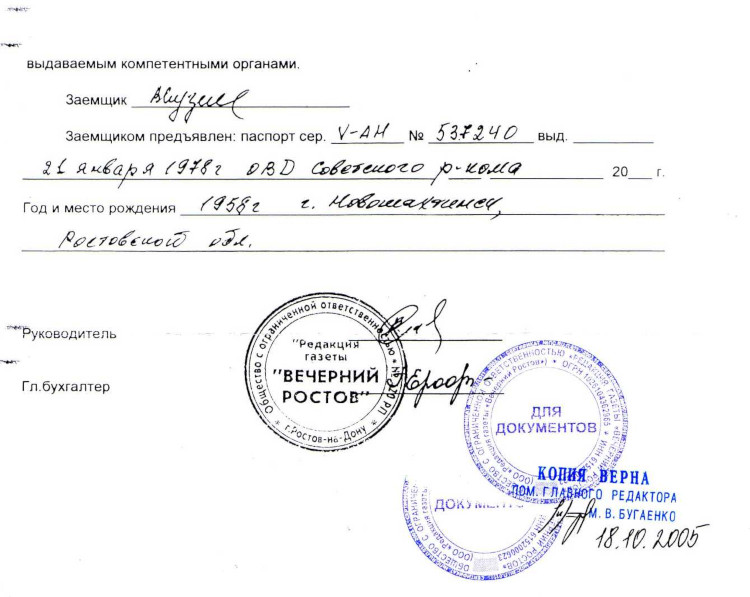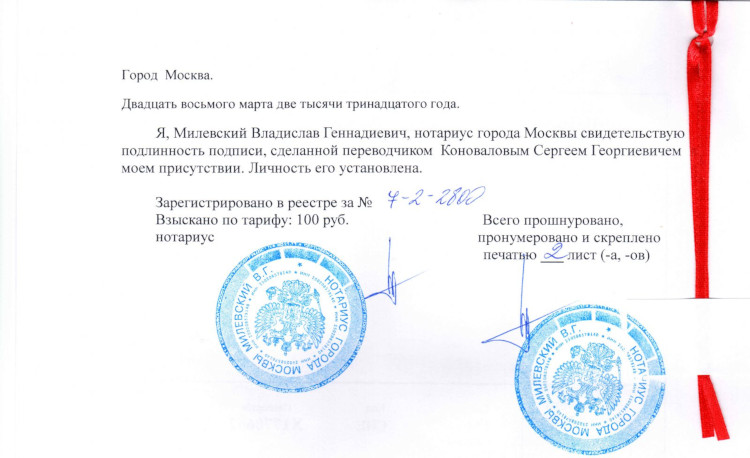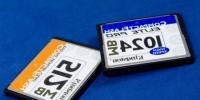How to properly certify a copy of a document: stamp "Copy is correct
Since the summer of 2018, a new procedure for affixing a visa “copy is correct” has been in force. How to properly certify a copy of a document according to updated standards and not violate the legal order of office work? We tell you what you need to know about copies and extracts, who has the right to endorse them and when a notary is needed.
How is a copy different from the original?
Some documents are developed only in one copy, and the creation of a second original is not possible. These include a work book, a contract between an employee and an employer (exists in 2 copies), a contract of sale, an order for employment. However, data from these papers is needed by banks, the tax service and some other institutions. For example, for issuing a loan or applying for a mortgage. It is impossible to provide them with the original, so a copy is made out.
A certified copy of a document is a paper photocopy of the document certified by the signature of the head and the seal of the organization (if any). The purpose of the visa is to guarantee credibility.
Copy - a copied version of the original document, most often performed on a simple copier. But to prevent fraud, institutions accepting copies are asked to certify them in a special manner. Let's take a look at the rules for certifying copies of documents in an organization and how to write everything correctly the first time.
The stamp "Copy is correct" is needed to confirm the authenticity of the copy
Why you might need a certified copy
Correctly certified copies are required by citizens and entrepreneurs in many situations:
- obtaining a loan or mortgage;
- registration of social benefits or material assistance;
- conclusion of real estate transactions (in certain situations);
- receiving an inheritance;
- issuance of a license.
Procedure for certification of copies of documents
The procedure for certifying copies of documents is actually quite simple, although it is regulated at the same time several pieces of legislation, one of which has been operating since 1983:
- Decree of the Presidium of the Supreme Soviet of the USSR of August 4, 1983 No. 9779-X;
- State standard of the Russian Federation GOST R 6.30-200 dated March 3, 2003 No. 65-st.
The legislation provides for 2 main certification options:
- simple;
- notarial.
A notary is most often required by business, and employees need a simple one - the signature of the employer. In remote rural settlements where there is no notary, this function is performed by the head of the municipality or his authorized deputy. Those acts that are prepared in the company itself are independently certified: orders and contracts. Approval of documents that are created by another institution is only legal when the originals are stored in the company itself. This rule most often applies to the work book.
Preparation of documents
Consider the general rules for certifying copies of documents. To obtain a certified copy, the employee, orally or in writing, applies directly to the employer or to the personnel department. A written application is prepared in free form. Usually the problem is solved within one business day, but in some cases it takes 2-3 days. For certification, you need the original and its copy.
If the original is kept by the employer, he himself makes a copy, certifies it and transfers it to the employee. The citizen's signature is not required.
Check the quality of the original. If some of the inscriptions are erased, there are erasures or fragments that are difficult to read, a simple photocopy will not be enough. The copy will be of poor quality and will not be accepted. How to act in such a situation? Try to scan the original and then print the scan. The quality will be better, and it doesn't matter to the receiving institutions how the copy is made.

The copy must be of good quality, otherwise it will not be accepted.
Who has the right to certify a copy
The right of assurance within the company has:
- manager/director;
- deputy chief;
- head of the personnel department;
- authorized person, if this right is fixed in the statutory documents of the organization.
If the organization has a seal, the signature must be secured with it. The stamp is placed in such a way as not to overlap the visa, position and decoding of the surname. A sample of the stamp "Copy is correct" is presented in the images to the material. If a legal entity works without a seal, the papers are certified only by a signature. The institution accepting copies must take this into account and does not have the right to refuse acceptance due to the lack of a seal.
Certifying inscription
The authenticity of the copy is confirmed by the wording "Correct". If a copy is being prepared for another organization - for example, for a bank - according to the new requirements, it is necessary to add the location of the original to this inscription. Thus, the inscriptions on copies of the same document will be as follows:
- Inside your company: “Correct”, the position and signature of the person approving the document.
- For another institution: “True”, “The original of the order for employment / other act is stored in Tekhnika LLC, case No. 03-1861 for 20 ..”, as well as the position and signature of the responsible compiler.
Sometimes the question arises: “the copy is correct” or “correct” - which is correct? The updated GOST assumes the spelling "True", it is better to use it. However, another wording will not invalidate the copy. A sample of how to properly certify a document is presented in the images to the material.
Notarization
Notarization of a copy is required only when it is expressly stated in the description of the set of papers. Entrepreneurs and legal entities are more likely to encounter notarization, for example, when registering an LLC. But in some cases, ordinary citizens are also forced to use such services. For example:
- marriage contracts;
- acceptance of an inheritance;
- translations of documents from foreign languages;
- powers of attorney with the transfer of rights;
- contracts for the sale of real estate, if the number of owners is more than one.
Notary services are paid, certification of one page will cost 1-2 thousand rubles. The notary will definitely need the original for notarization.

In order for a notary to certify a document, it must meet a number of requirements
In what cases the notary will refuse
The notary may refuse to certify documents. There are many reasons, the most common are:
- The applicant provides documents with laminated surfaces. The specialist cannot verify their authenticity, therefore, will refuse to certify.
- Papers of foreign origin, not legalized in accordance with Russian law, written in a foreign language.
- Acts on several sheets, but not stitched and not numbered (the problem is solved very easily: count and stitch the sheets, stick a label on the last sheet with the number of sheets).
- The original has damaged fragments that are difficult or impossible to read. Also, papers with notes and corrections, the legality of which is not confirmed by the mark "Corrected to believe", are not certified.
- Part of the text is written in pencil.
If there are doubts about the state of the document and the possibility of signing it in the proper order, it is better to initially consult with a specialist and try to find a solution to the problem together. After verification, the notary puts his seal: a sample of the seal is shown in the image above.
Peculiarities of certification of extracts from documents
In some cases, it is required to endorse not a copy, but only a separate extract. For example, from the charter of the organization, contract or resolution. How to do it right? There are no strict requirements for extracts, most of them are carried out in a free form and do not even require the signature of the head. For the statement to be considered valid, the following recommendations are sufficient:
- the date and registration number of the original document are indicated;
- if the document has a preamble, it is indicated in the extract without abbreviations and changes;
- only those paragraphs and lines that are relevant in this situation are left in the text, the paragraphs are indicated with the original numbers;
- indicate the position and name of the person who signed the main document.
Then the extract is certified with the stamp "Correct" and the signature of the compiler. Unlike certified copies, not only managers can endorse statements. For example, the secretary who compiled the extract has the right to put a stamp and his signature.
Certification of translations
Specialized translation agencies have the right to certify translated documents. There are such in almost every region and work with most languages. Only certified translators can translate. The applicant himself and the notary are not authorized to do so. Most notaries have the right to work with papers only in Russian.
Please note that sometimes only a translation of the document is required, and sometimes a translation and a notarized statement. Always specify at the place of presentation which option they require.
Conclusion
The new rules for certification of documents have not radically changed the order of endorsement of copies. In some cases - when a copy is presented to another organization - you need to indicate the location of the original (if possible). The head, his deputy and the head of the personnel department have the right of assurance. The procedure is simple and does not require serious preliminary preparation.




